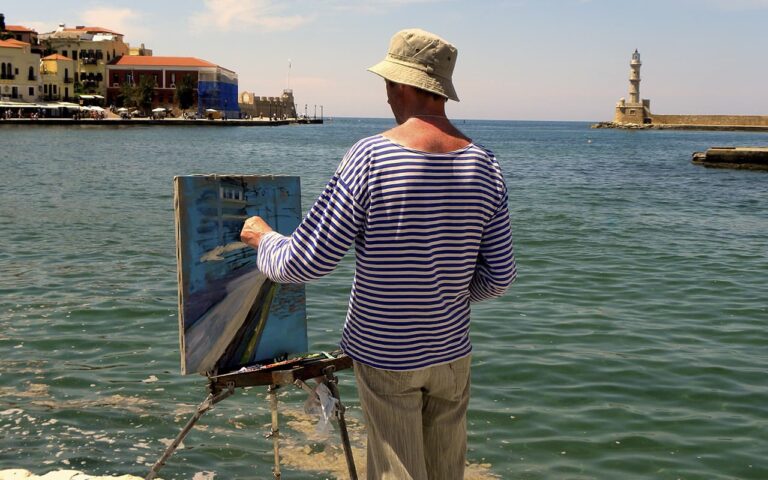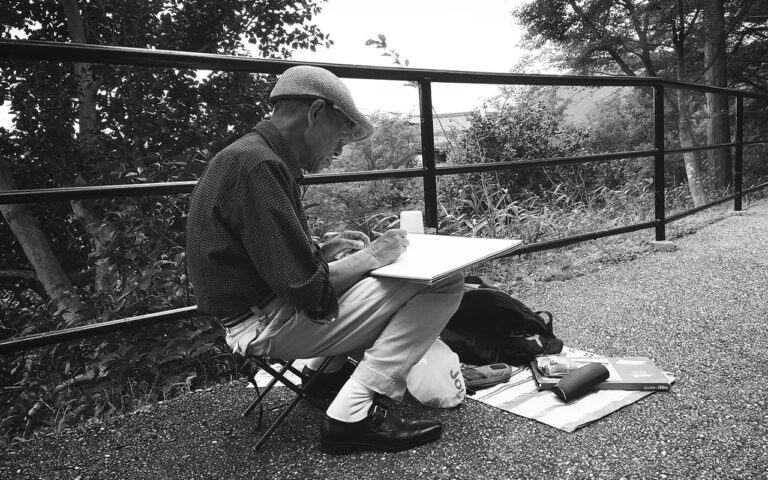Olin Herman Travis was a Dallas-based artist and teacher who worked intermittently in Arkansas for about twenty years. For three years in the late 1920s, he directed the Travis Ozark Summer Art School near Cass (Franklin County).
Olin Travis was born in Dallas, Texas, on November 15, 1888. He was the second of six children born to Olin Few Travis and Eulalia (Moncrief) Travis. His father was a printer. Travis graduated from Bryan High School in Dallas in 1906 and from Metropolitan Business College in Dallas around 1908. Fascinated by art since childhood and encouraged by his high school art teacher, Travis briefly studied in Dallas under Max Hagendorn. In 1909, he entered the school of the Art Institute of Chicago (AIC). He studied there for five years under the guidance of various instructors, including Charles Brown, Ralph Clarkson, Kenyon Cox, and Joaquin Sorolla y Bastida. He graduated with honors in 1914.
In 1913, Travis made his first trip to Arkansas accompanied by a classmate from AIC and spent four months sketching in the Ozarks. After returning to Chicago, he worked as an instructor at the AIC before taking a position at the Chicago Art Institute of Commerce.
Travis met Catherine Bess Hale while she was a student at the AIC in 1914. The couple married in Ozark (Franklin County) on November 15, 1916. They had two children. The Travises worked in the Chicago area before moving to Dallas in 1924, where they co-founded the Dallas Art Institute (DAI) with James Waddell. The first major art school in the South to offer training in a variety of fields, DAI closed in 1945. Travis was a teacher there and served as its director until 1941.
In the summer of 1927, the Travises founded the Travis Ozark Summer Art School in an abandoned sawmill near Cass. Catherine Hale Travis, who grew up in nearby Ozark, had painted in the Cass area as a child, and the couple was able to rent the sawmill buildings very inexpensively. The school, which was an extension of the DAI, was held every summer for three years (although evidence suggests that additional summer classes may have been held as late as 1935). Up to fifty students attended the school. The camp had about fifteen roughly furnished cabins and a house. Classes were held for one to two months, starting in June, and were open not only to DAI students but also to Arkansas residents and other students from neighboring states. On weekends, students exhibited their paintings and organized dances,
Travis traveled to Arkansas almost every summer from 1914 to 1935. During one of these trips in 1925, he met Everett Spruce, a teenager who lived in Mulberry (Crawford County). In 1926, Spruce moved to Dallas to study under Travis at the DAI and eventually became a well-known American artist.
Although Travis worked primarily in Franklin County, he also spent time in Eureka Springs (Carroll County) and parts of western Arkansas. He enjoyed painting not only the beauty of the Ozarks, but also capturing its people in their daily activities, such as peeling peas, making sorghum, and picking cotton. Travis collected sun hats and painted a series of paintings of Ozark women wearing headdresses. One of these paintings, Whither, won an award for figurative composition at the Texas Union Art Exhibition in 1930.
Travis also painted in Colorado, Florida, Michigan, and Missouri. He held numerous exhibitions in the Dallas-Fort Worth area for approximately forty years beginning in 1914 and also exhibited in New York, San Francisco, and Chicago. During this time he received many awards and held several solo exhibitions of his work, including a retrospective at the Dallas Museum of Fine Arts in 1953. Travis was one of ten Dallas artists whose paintings were included in the Golden Gate Art Exhibition in San Francisco in 1938. His painting, titled “Country School,” was based on an old schoolhouse he painted in St. Paul, Madison County. In 1940, Travis participated in the short-lived annual exhibition of the Arkansas Watercolor Society. Olin Travis also created a number of murals, including two completed in 1936 with themes based on the discovery of oil in East Texas. He was an excellent portrait painter and was highly praised for his painting The Laborer (1930), which traveled the country and won numerous awards, as well as for his portrait of a ragged man from the Great Depression era called Mayor Hoover (1929).
Travis was one of the founders of the Art League of the Southern States and helped create the Dallas Federation of Artists in 1946. He remained an active artist until his death on December 4, 1975. He was cremated in Dallas.


